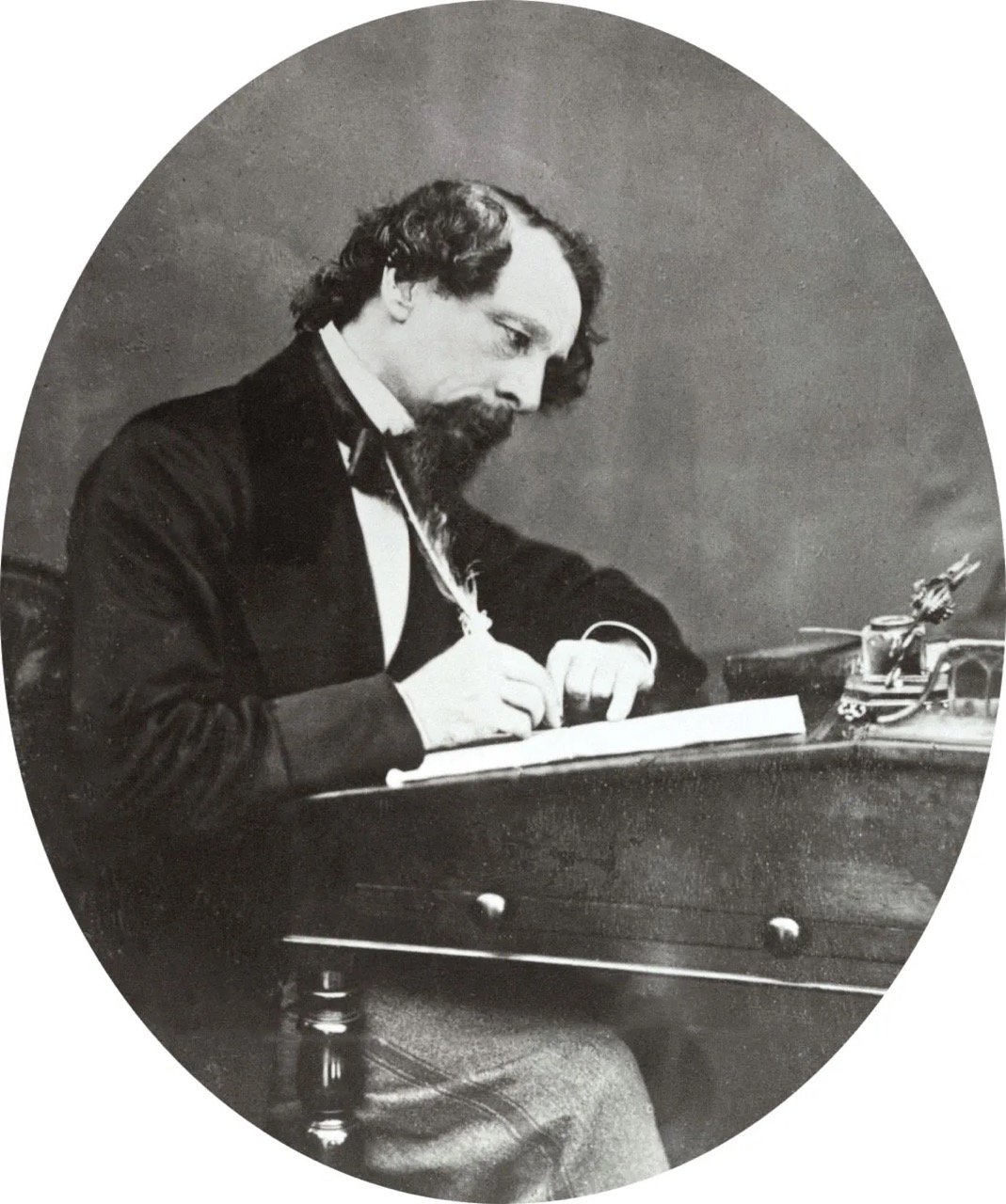A Blast Through Christmas Carol Past by Ilana Jael
Charles Dickens
Once upon a time, a poor man found himself struggling mightily in his quest to provide for his family. No, I’m not talking about A Christmas Carol’s Bob Cratchit—I’m talking about Charles Dickens himself, the man behind the classic tale.
Though Dickens was already a fairly successful writer by the point in his career at which he came out with Carol, the work that preceded it had sold far more poorly than expected. So, between that let down, some inherited debt, his habit of living beyond his means, and the fact that Dickens’ wife was by then expecting their fifth child, things were more than a little tight.
But though his hopes of making some quick cash did fuel the urgency with which Dickens found himself putting pen to paper, that wasn’t the only motivation at play during his creative process. He was also deeply passionate about child welfare, and, at the beginning of 1843 (the year in which Christmas Carol was published), had taken a trip to the Cornish Mines and found himself stricken by the appalling conditions he’d observed children working in there.
Shortly after, these feelings were only deepened by the publication of a government report detailing how widespread child labor had become in England in the wake of the Industrial Revolution, much of it involving similarly inhumane conditions.
His rage at this injustice was also partially fueled by one of his formative experiences; when he was 12, he’d briefly been sent to work in a blacking factory for a year after his father was sent to debtor’s prison. Because of this youthful hardship, Dickens became keenly aware of and sensitive to the suffering faced by those who lacked economic resources, a tendency which is clearly evident throughout his body of work.
Initially, Dickens had planned to express his concerns directly through the writing of a pamphlet, which was set to be entitled An Appeal to the People of England, on behalf of the Poor Man’s Child. However, he eventually decided that people would be far more likely to pay attention to his message if he delivered it through a compelling story as opposed to through cold hard facts.
Carlos Alayeto will play Ebenezer Scrooge in New City Player’s upcoming production of A Christmas Carol.
Thus, between this noble crusade to advocate for the impoverished and his personal need to keep himself out of the poorhouse, Dickens had quite a lot at stake in writing said story, which, of course, would turn out to be A Christmas Carol. Thus, as he began to write, he also began to drive himself into a kind of frenzy. A letter from his sister in law describes Dickens weeping, laughing, and then weeping again as he agonized over Carol’s composition. Unable to sleep, he would instead spend his nights pacing madly around London as he thought his way through the novel, sometimes strolling for as many as 20 miles at a time.
But, astoundingly, it took him only six weeks to emerge from this trance with the entire manuscript in early December of 1943—leaving Dickens just enough time to arrange publication of the work ahead of the winter holidays! The book was launched on the 19th of the month with an initial printing of 6,000 copies—and it became an immediate sensation. Critics raved about the work, with some even going so far as to call it a “new gospel,” and, sure enough, every single copy was off the shelf by Christmas Eve.
However, despite this whirlwind of success, Dickens still failed to achieve his original goal of improving his personal circumstances. Along with his insistence on making the book affordable and to ensure its message would disseminate, because he was set on it being on an aesthetically beautiful gift book, he also insisted on an ornate design, which raised production costs significantly. Thus, the profit he made ended up falling far short of what he required to stay financially afloat, which resulted in him having to sell his home and temporarily move his family to Italy, where the cost of living was much cheaper.
"What a wonderful thing it is, that such a great success should occasion me such intolerable anxiety and disappointment!" he commented on the unfortunate matter.
Though many subsequent printings would follow this initial run, Dickens still had trouble earning much money from A Christmas Carol due to the fact that copyright laws were loosely enforced during the period, and the book was so popular that it was quickly plagiarized by everyone else who found themselves in need of a quick buck. As well as pirated copies, unauthorized stage adaptations were also springing up rapidly- so much so that less than two months after the book’s publication, a full eight had gone into production!
However, the fact that Dickens had a great passion for the theatre ties into the way he did eventually find to make his masterpiece pay off. Funnily enough, he had considered making acting a career before his writing took off, and remained involved as an actor and director in amateur theatre productions throughout his life. Eventually, he was able to harness his theatrical skills by presenting public readings of A Christmas Carol and his other popular novels, which too became something of a sensation.
Like Dickens’ readings, the cast of It’s a Wonderful Life: A Live Radio Play will wear many faces! Pictured: Caroline Tarantolo
As one of Dickens’ biographers described:
"It was more than a reading; it was an extraordinary exhibition of acting... without a single prop or bit of costume, by changes of voice, by gesture, by vocal expression, Dickens peopled his stage with a throng of characters."
Given their popularity, these readings also were quite lucrative. During one three month reading tour of America, Dickens was able to earn 19,000 pounds—a sum that would be equivalent to $4.4 million dollars today!
But, of course, the impact of A Christmas Carol extends far beyond its creator’s wallet. For one thing, at least to some extent, it did serve its purpose, in that there was a documented increase in charitable giving after the book’s publication. More than that, the work also inspired countless acts of generosity and helped spur a lasting association between Christmas and charity that has endured even through the years.
As one newspaper editor put it in a letter to Dickens: “Blessings on your kind heart… you may be sure you have done more good by this little publication, fostered more kindly feelings, and prompted more positive acts of beneficence, than can be traced to all the pulpits and confessionals in Christendom.”
A Christmas Carol is also credited with helping to cement a certain vision of Christmas during a time when the changes wrought by industrialization meant a shift in the way the holiday was celebrated. While earlier Christmases had been characterized by community-wide feasts when society had been more agrarian, Dickens’ presentation showed that Christmas could be just as joyous if celebrated in an intimate gathering with family as it could in a town-wide blowout.
A Christmas Carol has also been credited with solidifying several now-ubiquitous Christmas traditions that are present in the story, and, in what has now been 180 years since its publication, it has never gone out of print. Along the way, it’s been adapted countless times, providing the source material for over 100 films, at least 20 television episodes, and a plethora of stage plays as well as some more out-there iterations such as graphic novels, operas, and video games.
In any case, given the great love Dickens had for the theatre as well as his passion for anything that would raise awareness of his preferred social causes, I’m pretty sure he would be quite pleased by our brand new adaptation of his work today!
A Christmas Carol: A Live Radio Play
Reimagined by Tyler Johnson Grimes
Directed by Timothy Mark Davis
Suitable for ages 10+
The year is 1971 and WNCP presents “A Christmas Carol,” the timeless Christmas tale reimagined once again as a live radio broadcast on stage. A jolly ensemble brings to life dozens of iconic characters and countless locales through the magic of live sound effects. The all too familiar story of scary spirits visiting Ebenezer Scrooge on Christmas Eve takes new twists and turns as unexpected people learn valuable lessons that might change their lives forever. This fresh and festive take on the greatest Christmas story ever told has something new for the whole family to enjoy!
WHEN
December 2-23, 2023
WHERE
Island City Stage
TICKET PRICE
$25-40
Make sure to plan your visit after booking tickets!




